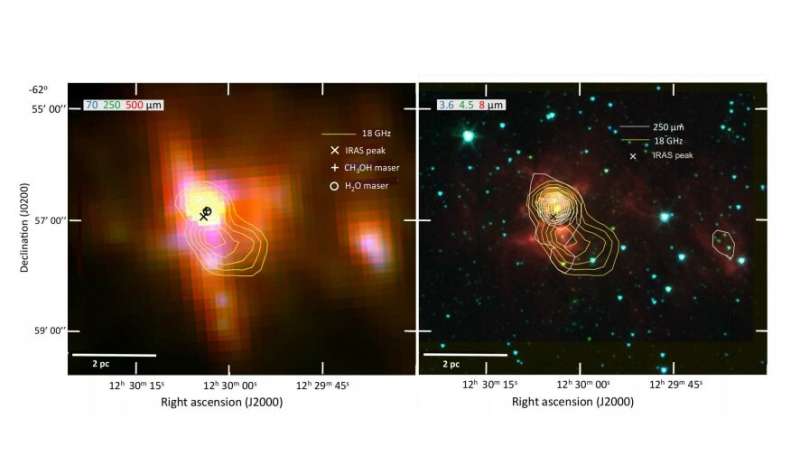July 6, 2020 report
Star-forming region IRAS 12272-6240 probed in infrared

Astronomers have conducted spectroscopic observations of a star-forming region known as IRAS 12272-6240. Results of this observational campaign shed more light on the nature of this massive and complex region. The study was detailed in a paper published June 25 on arXiv.org.
Star-forming regions are essential for astronomers to better understand the processes of star formation and stellar evolution. Observations of such regions have the potential to expand the list of known stars, protostars, young stellar objects and clumps, which could be then be studied comprehensively in various wavelengths in order to get more insights into initial stages of the stellar life cycle.
Located some 30,300 light years away, at the far end of the Carina-Sagittarius arm of the Milky Way galaxy, IRAS 12272-6240 is a complex star-forming region with a compact massive dense clump and several associated masers.
A team of astronomers led by Mauricio Tapia of the National Autonomous University of Mexico took a closer look at IRAS 12272-6240. Using the Baade/Magellan telescope in Chile, they performed near-infrared imaging and low-resolution spectroscopy of this region. The study was complemented by data from the Herschel Infrared GALactic Plane survey (Hi-GAL) and from NASA's two spacecraft: Spitzer and Wide-field Infrared Survey Explorer (WISE).
"In this work, we present new sub-arcsec broad- and narrowband near-IR imaging of a 120 x 120 square arcsec area centered on the massive star-forming region IRAS 12272-6240. We supplemented these data with HI-GAL/Herschel far-IR images combined with archive IRAC/Spitzer and WISE mid-IR observations," the astronomers wrote in the paper.
The observations found that IRAS 12272-6240 has a compact massive (around 13,100 solar masses) dense dust clump containing two young stellar objects (YSOs) of Class I, designated Irs-1N and Irs-1S, and associated methanol, hydroxide as well as water masers. The two YSOs probably form a binary system that is about 21,000 AU wide.
The data suggest that the central star of IRAS 12272-6240 is most likely of spectral type O9V, has an effective temperature of about 33,500 K and is about 23 times more massive than our sun. The central star seems to have a pre-planetary disc with a mass of 0.01 solar masses at an inclination angle of 32 degrees.
The astronomers were able to distinguish two embedded clusters in IRAS 12272-6240 differing in age, spatial distribution and physical characteristics. The older and more extended of these two is about 1 million years old, contains more than 50 stars in its nucleus and a halo of some 80 fainter stars extending to a radius of about 4.24 light years. The second one, consisting of at least 35 identified members, is estimated to be significantly younger than 1 million years and appears to be more deeply embedded.
According to the paper, the results confirm that IRAS 12272-6240 is a giant young complex located where massive star formation processes started some one million years ago and is still active at its nucleus.
More information: An infrared study of the high-mass, multi-stage star-forming region IRAS 12272-6240, arXiv:2006.14692 [astro-ph.GA] arxiv.org/abs/2006.14692
© 2020 Science X Network



















